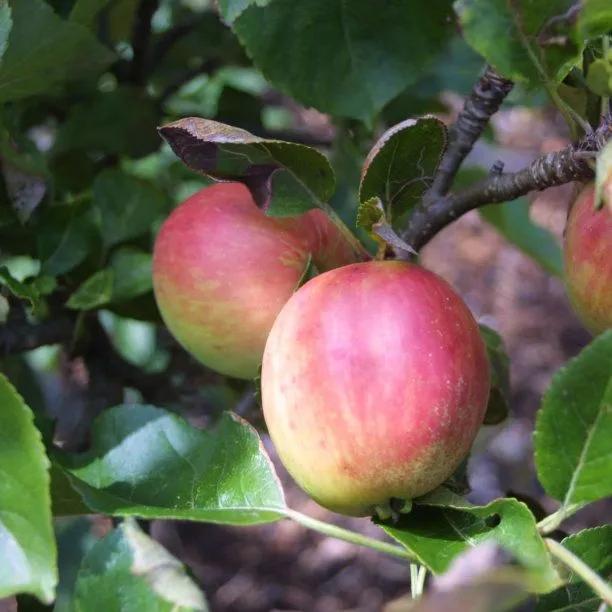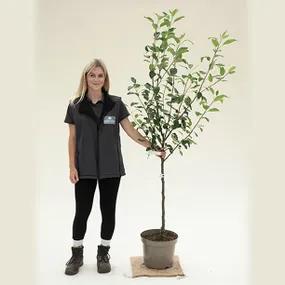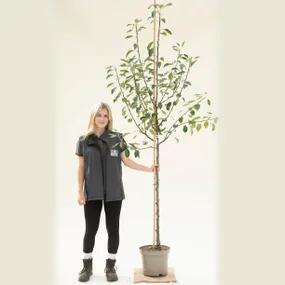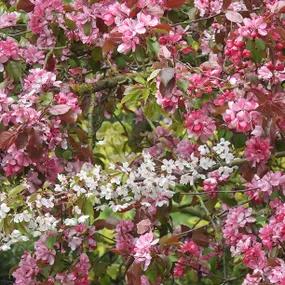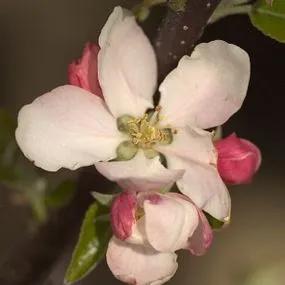Coxs Orange Pippin Apple Trees
The details
- Eating: Supreme flavour. Quite soft flesh, very juicy.
- Spur bearer
- Self fertile
- Pollinator
- Pollination Group C
- Crops in Late Sept / Early Oct.
- Store for 3 weeks
- Low vigour.
- Not recommended for organic growing
Description
Cox's Orange Pippin Apple Trees : Eating
Cox Orange Pippin trees carry quintessentially English eating apples that juice very well: in a good year, one of the all-time best tasting apples. It has a wonderful juicy texture and a complex, tangy, aromatic taste with a hint of spices and suggestion of melons. It only stores for 3 weeks, so freeze the juice from your excess apples.
The tree is quite slow-growing and upright; it's ideal for low maintenance cordons & espaliers.
Browse our range of apple trees, or all our fruit trees.
Read our guide to buying apples.
Delivery season: Bareroot plants are delivered in late Autumn to Spring, about November-March inclusive. Pot grown plants, year round.
Features:
- Eating: Supreme flavour. Quite soft flesh, very juicy.
- Spur bearer
- Self fertile
- Pollinator
- Pollination Group C
- Crops in Late Sept / Early Oct.
- Store for 3 weeks
- Low vigour.
- Not recommended for organic growing
- More disease prone in the humid West
Growing Cox Apples
Apples like rich, well drained soil, and will thrive on clay in locations that do not get waterlogged in winter.
A full day of sun and shelter from the wind is ideal.
Cox's Orange Pippins are more susceptible to disease than most, unsuitable for organic growing commercially.
It is not ideal for the more humid, warmer areas in the West and South of Britain, where scab and canker are more common. Although it will perform better in a cooler climate, it is not recommended for the North & Scotland because its flowers are easily damaged by late spring frosts.
They are generally happier in the drier Eastern parts of the country, although we have a large stock tree here in Somerset that crops wonderfully, thanks to the attention we give it. We do not spray it apart from with organic winter wash, we only follow best practice: plenty of mulch annually, sweeping up fallen leaves and fruit, removing bad ones, and some water in a dry summer spell so the tree is never stressed.
Rootstocks:
We use MM106 for Cox, the UK standard for medium-sized trees, ideal for gardeners. It gives a half-standard about 4m tall, and a bush about 3m.
MM106 maidens are suitable for cordons and espaliers, but we use the less vigorous M9 for our ready-made cordons.
Cox Disease notes:
Disease susceptibility: Scab, Canker (high), Mildew, Fireblight, Cedar Rust, Bitter Pit (moderate). Recommended alternative is Fiesta, which has similar flavour and better disease resistance.
Pollination Partners for Cox
Your trees are self fertile, making decent crops without a pollination partner, but still perform best with one.
Cox is in Pollination Group C, which cross-pollinates with other apple trees in Groups B, C and D.
Use our Fruit Pollination Checker to quickly find pollination partners, or Apple Pollination Guide to learn more.
Planting Instructions
Notes on planting Cox apple trees:
All fruit trees like a rich soil with decent drainage, protection from the wind and plenty of sun. Apple trees like clay soil, as long as it is not prone to bad waterlogging.
This tree is unsuitable for organic growing.
It is not ideal for the more humid, warmer areas in West and South of Britain, where scab and canker are more common. Although it will perform better in a cooler climate, this tree is not recommended for the North & Scotland because its flowers are easily damaged by late spring frosts.
Prepare your site before planting:
Improving the soil helps trees establish quickly and be productive for years. Preparing weeks or months in advance gives best results: fill the planting hole back up, don't leave it open to either dry out or fill with water.
- Destroy weeds and grass,
- Dig the soil over, remove stones, then mix in well rotted compost or manure down to the depth of about 2 spades, unless you are on heavy clay:
- On thick clay soil, only dig over the soil to break it up. Apply organic matter as a mulch over the soil after planting.
Spacing apple trees:
- Freestanding bushes: 15-18 feet (5-6m) between trees and rows.
- Freestanding half-standards: 18-30 feet (6-10m) between trees and rows.
In general, allow 1 more metre between rows than between trees along the row.
- Wire-trained cordons: 60-100cm apart along a row.
- Espaliers: 10-18 feet (3.5-6m) apart.
- Watch how to plant a fruit tree for a bush or half-standard.
- To grow a cordon or espalier, you need to install sturdy training wires.
Pruning apple trees:
- Maidens can be pruned in any style, including into bushes or half-standards.
- Bushes - start here when you buy a bush.
- Half-standards - start here when you buy a half-standard.
Accessories:
For bush and half standard apple trees, a tree planting pack, which includes a wooden support stake & rubber tie (a bamboo cane is enough support for a maiden), and a biodegradable mulch mat, with pegs, to preserve soil moisture stops and prevent weeds.
We strongly recommend using mycorrhizal "friendly fungi" on the roots of all transplanted trees.
Winter wash and greasebands are effective, organic pest prevention.
Did You Know?
The original COP was bred around 1825 by Richard Cox of Buckinghamshire. One of its parents is thought to be the Ribston Pippin. The nurseryman Charles Turner began selling it in the 1850's. This self-fertile variety was developed from a sport of the original tree in Kent and released in 1994. It appears on any list of the greatest British eating apples.
Apple Tree Delivery Shapes:
Most of our fruit trees are delivered in up to 3 shapes (maiden, bush, and half standard), scroll up to see what's in stock.
Maiden: Unbranched tree, the most basic starting size, which you can train into the other forms (apart from mini patio trees).
Bush: Freestanding tree with a short trunk about 60cm tall. It will grow to about 3m. Ideal for small gardens.
Half-Standard: A freestanding form with a trunk about 120cm tall. It will grow into a full sized, "normal" apple tree, about 4m. Ideal for orchards, easy to mow underneath.
Cordon: Cox is a spur-bearer, suitable for cordons and espaliers.
Guide to Fruit Tree Sizing.

